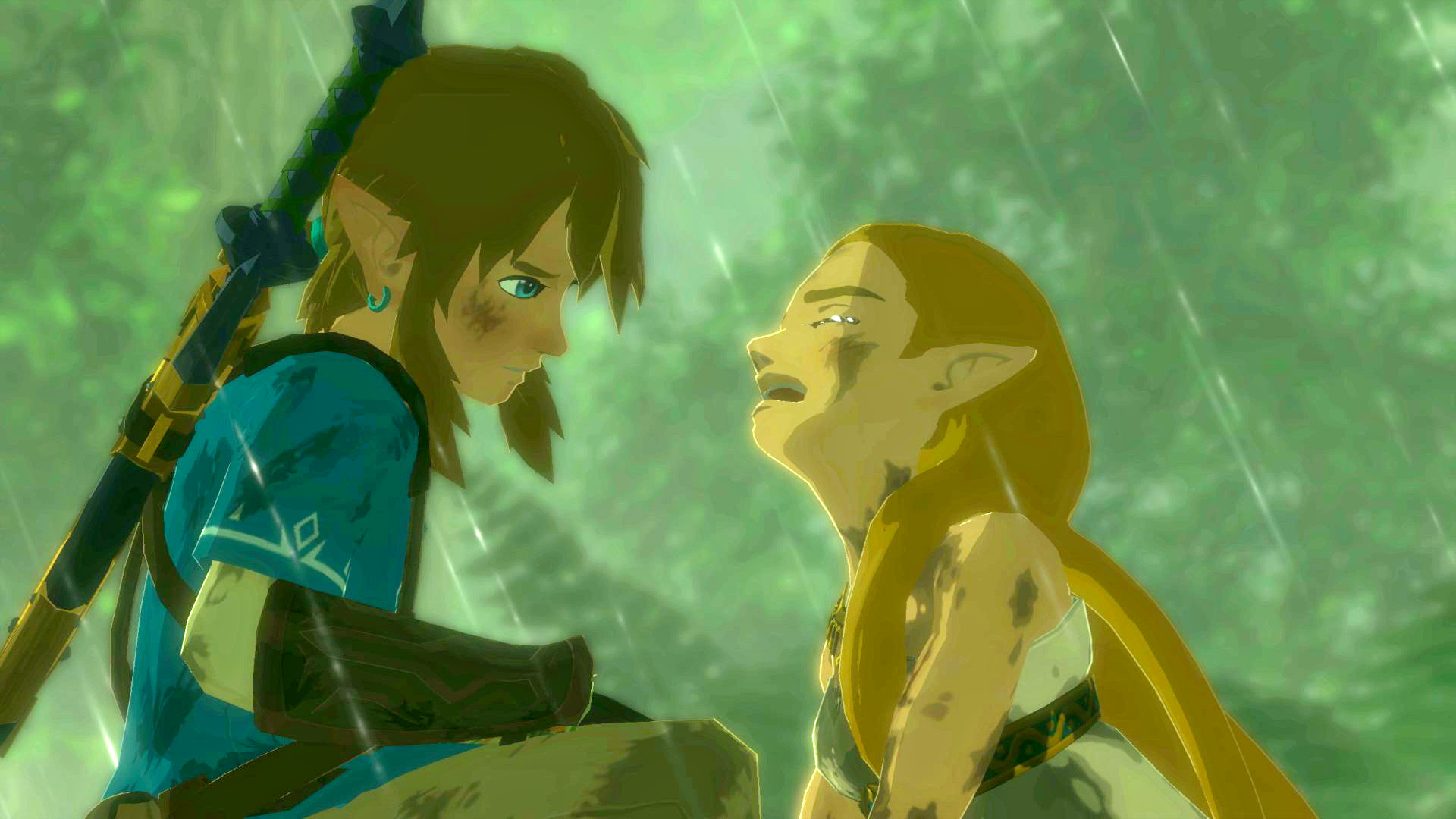Zelda: Breath of the Wild is an amazing game. I’ve played around 60+ hours of Nintendo’s flagship Switch title, and I still find myself enamored by new discoveries and my wonderfully unique moments within the game’s sandbox.
It is undoubtedly a foundational game, one which has been appropriately applauded for its excellence—but it constantly gets in its own way with design choices directly opposed to the rest of the game’s strengths.
Breath of the Wild stands out in how it entices the player: how every cliff invites you to climb it (if I could just rest on that ledge…); how every bend in the road leads to some mysterious edifice for investigating; how every mountaintop treats you with a vantage point to new towers, shrines, and all manner of adventures to pursue. But there are a few questionable design choices that needlessly hinder and, in some cases, completely obstruct these marvelous encounters.
Rain
In my mind, there are two Zelda games here: Breath of the Wild—a spectacularly inviting and fun open-world game—and Breath of the Wild While Raining—an awful, stuttering game predicated on interrupting the fun I was just having with the other game.
Breath of the Wild’s rendition of Hyrule is a stunning landscape to behold, no matter which of its various locales you find yourself exploring. Over and over again, I find myself halting my pursuit of hidden Shrines and Korok seeds just to look out at the world and enjoy the peaceful rustling of the grass and the occasional piano interpolation, ornamenting the sweet silence of this lush wildland.
Then, I see the clouds roll in. “Well, that was too good to last.”
In Zelda: Breath of the Wild, rain has a functional effect on the gameworld. Climbing becomes nearly impossible because Link will slip down a few feet with every six-or-so leg-ups. This becomes less punishing once you’ve obtained the Climbing Gear armor set, but only by a slight margin.
Rain also has elemental effects, meaning open fires get put out, and lightning storms (which accompany rain more often than not) will render Link’s metal-based gear (shields, bows, etc.) hazardous to wear.
Every time I see those little droplets start to spread across my screen, I’m filled with dread at the thought of having to post up and wait at the nearest stable—because that’s what I do now. What’s the point of trying to progress when the game is incessantly saying ‘no’ to your every endeavor? No, you cannot climb this wall. No, you cannot use 90% of your weapons. No, do not gaze enviously upon the vastness of Hyrule’s fields. No, don’t cook or sit by a fire and wait for the rain to pass—it will never pass.
For a game that achieves so much simply by saying “yes” to the player, frequently putting a literal damper on the fun by raining cats and dogs with a resounding “no” is a hard con to gloss over. I’ve never found myself more conflicted about a design choice so antithetical to the rest of such an excellent game.
I definitely enjoyed the very first time I encountered a thunderstorm in Breath of the Wild—an enamoring random event which both frightened and excited me.
“Oh, so it rains. Very good. Oh man, and lightning too!….Jeeze, that lightning is some serious—holy shit, that was close! Oh. Oh man, this is serious. Wait, why are there sparks flying from me. Oh no—”
It was one of the many momentous, emergent sequences that I remember most vividly from my time with this wonderful game. But the memory is tarnished, as I now associate it with my many hours of hating the fucking rain.
Shield Surfing
I have no scruples with Breath of the Wild’s weapon degrading system. I will, of course, become attached to a weapon and will find myself dreading its inevitable demise, but it’s all in service of a fun and experimental cycle that makes the game quite unique.
But shield surfing is something that should be excluded from this system. Shield surfing is, by far, one of the best things about this game. Being able to scope out something in the distance (preferably at a lower altitude) and hop onto my shield for some swift, radical traversal is insanely satisfying.
Again, Breath of the Wild’s design gets in the way of this fun. I desperately want to surf all the time, but I dare not when I have a particularly excellent shield I had procured from a troublesome Lynel. Of course, I could always hang on to a separate shield designated for surfing, but part of the appeal to shield surfing is the immediate readiness of it; the fact that I could at any moment spontaneously start riding down any slope is miraculous and, not by accident, perfectly in line with the rest of the game’s mantra.
Inflicting such an unforgiving amount of damage to your shield as a result of this euphoric form of play goes beyond tactically limiting; I understand the need for reservation in a survival-skewed game like this, but can’t I just ride my shield and be totally awesome? Thanks.
The Lost Pilgrimage
Click to play GIF

I love the Lost Woods. The search for the Master Sword was easily one of the most compelling self-commissioned quests I’ve endeavored in any game. It’s somewhat subtle, and quite brilliant, how Nintendo puts you on the path to finding the Sword that seals the Darkness; we all knew the Master Sword was in this game, but it’s never directly referenced until you find it. I heard talk of the sword hidden in the forest, and my good friend Hestu (the Korok Seed dude. You know, the one with the maracas!) once told me that the forest was located in the northern regions of the map, and thus, my quest for the sword began. Upon unlocking a region of the map, a secluded collection of trees revealed itself to me, and I knew that was where my blade resided. The moment I walked into the Lost Woods, heard the music begin, and saw the words The Lost Woods appear on my screen, my hands shook. It was quiet, yet thrilling.
Navigating the forest was also profoundly exciting. Carefully progressing and quickly retreating upon threat of becoming engulfed in mist, I determinedly bore my way through the nebulous path that would undoubtedly lead me to the blade to end all weapon-degrading grievances.
This determination, and the promise of such high reward, was key to the Lost Woods’ profound effect — and it’s what The Lost Pilgrimage lacks.
In The Lost Pilgrimage, Link is asked to accompany an audacious young Korok, Oaki, as he navigates his way through the Lost Woods to one of its hidden Shrines. However, to save Oaki’s pride, Link must not be seen as he watches over the little Korok as he ventures into the wood.
Sound familiar?
Not only does the mission lack the suspense of the quest for the Master Sword, it actually latches onto the Lost Woods’ mechanics in order to create an infuriatingly rigid and unforgiving quest uncharacteristic of the rest of the game.
It also plays a lot of tricks on the player—pushing you to keep close behind Oaki, then suddenly having him turn around and run in your direction, landing you in Detected-ville; forcing you to take action when the little Korok gets jumped by a wolf; and a few other decidedly unfair traps to get you caught. And once you’ve been spotted, it’s back to the beginning of the trial. (There’s a really great play-by-play recounting this nightmare of a sidequest that you really should check out!)
Yiga Clan Surprise!
I actually love the Yiga Clan fights. These ninja-like thieves/assassins present some of the most challenging 1-on-1 combat instances of any Zelda game, and the cringe-worthy humor which proceeds so many of these encounters can be ironically enjoyable.
But I’ve gotten to a point in the game that every time I see a lone NPC standing idly along the road, I approach with bored exasperation.
This doesn’t actually hinder the great experience that is Zelda: Breath of the Wild—again, I happen to love these encounters—but after a certain point, these thugs become less an intimidating cult of killers and more a group of really annoying sore losers.
Seriously, fuck the Yiga Clan.
Joe's favorite games are Zelda: Majora's Mask, Dishonored, Super Mario Bros. 3 and Hearthstone. His favorite game is not The Witcher 3 because he hasn't played it yet.

See below for our list of partners and affiliates:

























